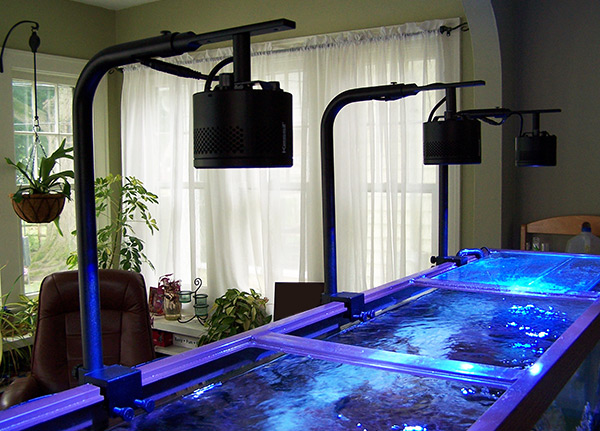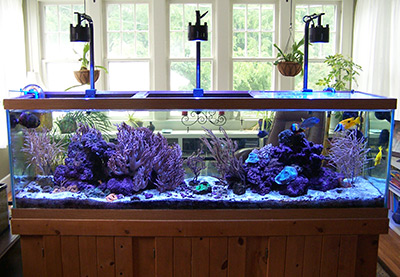Regular Saltwater Smarts visitors may recall that back in the spring of 2015, I closed down my 75-gallon reef tank and converted my 125-gallon (then) FOWLR tank to a reef system with the addition of some invertebrate livestock from the 75 and a Current USA metal halide/T5 combo light fixture donated by Caribbean Chris.
Fast-forward to May of this year, and it was time to consider new lights. I was really pleased with the look of the lighting that the Current USA fixture produced. However, it did have a few drawbacks.
For one, it was really heavy and required two people to remove for water changes and other tank maintenance. Also, the rather flimsy support legs used to mount the fixture on the tank weren’t really up to the task and broke quite easily. (Suspending the fixture from the ceiling was not an option and, according to my wife, could cost me my life.)
Another issue was that the fixture—which, though new for me, was actually rather old by most people’s standards when I got it—was getting a bit buggy, with the switches failing one by one and some of the T5s working intermittently.
Last but not least, running all those lamps and the fan to cool them was adding a considerable sum to our electric bill each month. It was this last point that really got my wife on board with a lighting upgrade.
But upgrade to what? I was reluctant to give up metal halides, favoring the coral growth they promote, their sun-like intensity, and the attractive glimmer lines they produce, but we really wanted to find something that runs cooler, consumes less energy, and doesn’t come with such a burdensome expense for routine bulb/tube replacement. It seemed LEDs were the best solution given my needs and circumstances.
Nonetheless, I was wary. Most of the LED systems I’d seen produced an undesirable “thousand points of light” effect in the tank—that is, multiple tiny spotlights plunging down through the water column. To me, this looks more like a special effect than natural sunlight. I really didn’t want that and hoped there was a better alternative. As I researched the various options, it was also surprisingly difficult to find a mounting solution that made sense for my 72-inch-long tank (recall that ceiling mounting would be hazardous to my health).

Once again, it was CC who pointed me in the right direction. While doing parallel research to help me find something suitable, he happened upon Kessil LEDs (not to be confused with the Spice Mines of Kessel), specifically the company’s A360 series. These units, it seemed, would satisfy all of my lighting wants and needs, being very lightweight, compact, and quiet in operation, while providing good color, coverage, and penetration. In addition, Kessil offers a mounting arm that appeared to be a good solution to that particular dilemma. Best of all, it was claimed that the lights produce excellent glimmer lines!
My wife and I hemmed and hawed for a while before actually committing to the purchase. I wouldn’t characterize the lights as particularly expensive as quality LEDs go, but for us, they amounted to a significant investment at a time when some other major bills were coming due. But no other option seemed to make better sense or offered a better mounting solution. Certainly I could find something with a lower upfront cost, but any initial savings would just be offset by the ongoing cost of bulb replacement and higher energy consumption. So we decided to pull the proverbial trigger.
I went with the A360W-E Tuna Blue LEDs. Each unit covers a 24-inch-diameter area, so I needed a total of three for my 125-gallon. I also bought three mounting arms and two link cables. These cables allow you to daisy-chain multiple lights together so you can control the whole line with just one of the lights or with an external controller. However, each of the lights has its own color and intensity controls, so it’s not necessary to daisy-chain them if you’d rather not.
The mounting arms, which are easily adjustable both vertically and horizontally, are a no-brainer to assemble, and attaching the lights to them is a snap. Once assembled, they screw right onto the rim of the tank with no muss or fuss. Also, the arms are designed so you can run the light cords inconspicuously through them, helping to streamline the setup.
I do have one issue with the mounting arms—though it has more to do with my particular application than with any limitation inherent to the arms themselves. That is, because my tank functions as a room divider and is viewable from three sides, the view on the side that the lights are mounted on is somewhat diminished, and when you view the tank from the opposite side, the very bottom of each arm is visible just below the surface of the water. But this would be a total non-issue with a tank that is situated against a wall and/or has an opaque background of some sort.

Am I pleased with the quality of the light? Very much so. True to the company’s claims, the coverage and penetration are quite good. As far as the color is concerned, I’d have to say my old metal halides win by a hair, but it’s still quite satisfactory and you can adjust it somewhat to your taste. And because the LEDs are concentrated in a tight array, the aesthetic impression they produce is very similar to that of metal halides—excellent glimmer lines without the “thousand points of light.”
I initially set the intensity of the lights at about 60 percent so my corals could acclimate to the change, but even that proved to be too much at first (LEDs tend to be much more intense than they appear to the human eye). They all closed up and sulked. So I backed off the intensity to about 50 percent and they seemed happier with that. I’ve since gradually increased it to about 70 percent and everyone appears to be doing well.
So, all in all, I’d have to say “So far so good!” when it comes to my Kessils. They were very easy to set up, they’ve made it much easier for me to access my tank for routine maintenance, and I have no qualms with their performance. If my opinion of them changes for any reason, I’ll be sure to share any new insights with all my fellow salties here at Saltwater Smarts.



